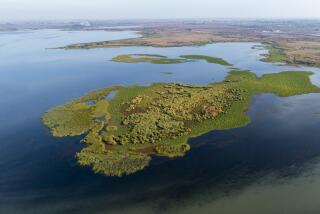Filtering Plants to Be Years Late : Health: The DWP says the deadline for three state-mandated water purification facilities can’t be met due to enormous cost and scope.
- Share via
With a deadline just a week away, Los Angeles water officials said Tuesday they will be a decade late in building a string of costly filtration plants the state has mandated to purify drinking water exposed to the elements in Encino, Hollywood and Stone Canyon reservoirs.
And in their first estimate of the effect on rates, Department of Water and Power officials said the three filtration plants, costing roughly $150 million apiece, could raise the average customer’s water bill by $3.20 per month for 10 years, a rate increase of about 12%.
DWP officials also said the last of the three plants may not be finished until 2003, despite the state deadline of next Tuesday to have the plants in service. They have applied to the state Department of Health Services for a deadline extension and for a waiver of a requirement that the department meanwhile warn customers that open reservoirs pose risks of waterborne disease.
State and federal regulations require filtration of water kept in large water storage lakes like the three DWP reservoirs.
The rules reflect concern over bacteria, viruses and other contaminants entering the reservoir in storm runoff. The concern is not only that chlorination may not fully destroy microbial impurities. It is also that chlorination byproducts, known as trihalomethanes, may be hazardous themselves. The more chlorine is needed, the more trihalomethanes result.
While stressing that water served to DWP customers meets all applicable health standards, DWP officials have said they support construction of filtration plants----if only to reduce complaints about the taste and odor of highly chlorinated water, and to meet future limits on trihalomethanes in drinking water.
But they said Tuesday’s deadline is impossible to meet, due to “the enormous scope” and cost of the construction projects, and continuing negotiations with homeowner groups opposed to having the filtration plants in their neighborhoods.
Bruce W. Kuebler, director of water quality for the DWP, said the agency does not expect to complete the first of the plants, serving lower Stone Canyon Reservoir in Brentwood, until 1996 and may not finish the last, at Encino Reservoir in the hills above Ventura Boulevard, until 2003.
In addition to requesting a new timetable, the DWP will ask the Department of Health Services to a waive a requirement that the department issue printed notices warning customers that high microbial contamination poses a risk of “diarrhea, cramps, nausea, and possibly jaundice and any associated headaches, and fatigue.”
That boilerplate language in the state regulation “doesn’t seem to fit with the physical facts that we have been serving this water for umpty-ump years” without apparent ill effects, Kuebler said.
“I drink the water every day. I have no doubts about the safety. . . . I don’t think the warning is necessary or justified by the situation we have in the city.”
If the request is granted, the DWP would still have to tell customers in advertisements and billing notices that it missed the deadline for completing the filtration plants. However, it would be allowed to omit some of the warning language.
Gary Yamamoto, Los Angeles district engineer for the state health department’s office of drinking water, said he agreed the warning language may be “more harsh than it needs to be”----at least for customers served by Encino and lower Stone Canyon reservoirs. But Yamamoto said the service area around the Hollywood Reservoir in the Cahuenga Pass just southeast of Universal City might still get the full-blown warning because that reservoir sometimes experiences high coliform bacteria levels.
Water from the three reservoirs supplies one fifth of the DWP’s 3.5 million customers, mainly in Hollywood and the Westside and portions of the San Fernando Valley. The water is chlorinated as it is drawn from the reservoirs to be pumped to homes.
Kuebler said the $3.20 per month estimate assumes that the full $400 million to $500 million construction cost would be covered by customer billings over a 10-year period. He said the total tab would be higher--but the monthly rate increase lower--if a portion is financed through bond sales, as is usually the case.
Groups representing those who own expensive homes near the three reservoirs have protested construction of the filtration plants, saying they would cause traffic and safety problems, lower property values and spoil lakeside views. They have also questioned whether a small increase in health protection is worth so high a cost.
Saying it does not want to repeat a past mistake--trying to ram unpopular projects down peoples’ throats--the DWP for more than two years has been engaged in formal mediation with the neighbors to deal with siting, safety and design issues.
But some homeowner activists have supported the plants and accused the DWP of dragging its feet. Supporter Gerald A. Silver, president of Homeowners of Encino, whose members generally live some distance from Encino Reservoir, said the DWP has used the mediation process as an excuse for delays.
“This is an expensive project and they would like not to build it if they could save the $400 million,” Silver said.
“Going into mediation buys them years and years of looking like they’re doing something . . . and nothing’s being done,” he charged.
But Kuebler said mediation has been helpful and may save time in the long run, even if it does not prevent homeowners from suing to block construction of the plants. “If we do have a lawsuit, I think it would be handled much more easily than if we didn’t have this process,” he said.
More to Read
Sign up for Essential California
The most important California stories and recommendations in your inbox every morning.
You may occasionally receive promotional content from the Los Angeles Times.










